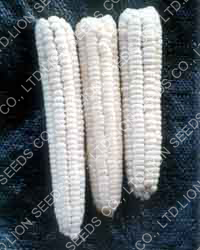
Glutinous White 8
This glutinous corn has medium ears and dense kernels. The test is little sweet and very tender. Maturity is in 60-65 days after sowing.
CORN FACTS: The tall, annual grass has a stout, erect, solid stem and large narrow leaves with wavy margins, spaced alternately on opposite sides of the stem. Staminate (male) flowers areborne on the tassel terminating the main axis of the stem. The pistillate inflorescence, maturing to become the ear, is a spike with a thickened axis, bearing paired spikelets in longitudinal rows, each row of paired spikelets normally producing two rows of grain. The spike is enclosed by modified leaves, called shucks or husks.
Commercial classifications, based mainly on kernel texture, include dent corn, flint corn,flour corn, sweet corn, and popcorn. Dent corn is characterized by a depression in the crown of the kernel caused by unequal drying of the hard and soft starch making up the kernel. Flint corn, containing little soft starch, has no depression. Flour corn, composed largely of soft starch, has soft, mealy, easily ground kernels. Sweet corn has wrinkled, translucent seeds; the plant sugar is not converted to starch as in other types. Popcorn, an extreme type of flint corn characterized by small, hard kernels, is devoid of soft starch, and heating causes the moisture in the cells to expand, making the kernels explode. Improvements in corn have resulted from hybridization, based on crossbreeding of superior inbred strains.
Commercial classifications, based mainly on kernel texture, include dent corn, flint corn,flour corn, sweet corn, and popcorn. Dent corn is characterized by a depression in the crown of the kernel caused by unequal drying of the hard and soft starch making up the kernel. Flint corn, containing little soft starch, has no depression. Flour corn, composed largely of soft starch, has soft, mealy, easily ground kernels. Sweet corn has wrinkled, translucent seeds; the plant sugar is not converted to starch as in other types. Popcorn, an extreme type of flint corn characterized by small, hard kernels, is devoid of soft starch, and heating causes the moisture in the cells to expand, making the kernels explode. Improvements in corn have resulted from hybridization, based on crossbreeding of superior inbred strains.
